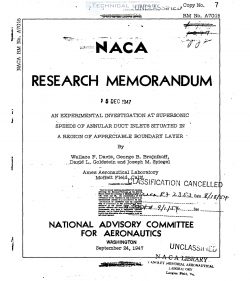naca-rm-a7g15
- Version
- 88 Downloads
- 1.63 MB File Size
- 1 File Count
- April 20, 2017 Create Date
- April 20, 2017 Last Updated
An Experimental Investigation at Supersonic Speeds of Annular Duct Inlets Situated in a Region of Appreciable Boundary Layer

Annular air inlets situated several diameters behind the apex
of various bodies of revolution were tested over the range of Mach
numbers between 1. 36 and 2. 01 to determine the effects of relatively
thick boundary layers upon the characteristics of duct entrances in
supersonic flight. With all the models tested, the recovery of
total pressure after diffusion to a low subsonic velocity was found
to be approximately two-thirds of that through a normal shook: wave
occurring at the same free-stream Mach number. Schlieren photo-
graphs show that the cause of this low-pressure recovery is the
interaction between the boundary layer and the back pressure in
the diffuser; when the back pressure reaches only a moderate value,
the boundary layer thickens and separates upstream of the duct
entrance. Once separation has occurred, the i‘low through the inlet
fluctuates violently.
A comparison of an inlet situated several diameters behind the
apex of a body with an inlet having only a short, 50° cone ahead of
it showe that, even though the thickness of the laminar boundary
layer is apparently about the same in each case, the total-pressure
recovery attainable with the 50° cone model is more than 30 percent
greater at a Mach number of 1.70. This large difference in
pressure recovery is caused by the greater local Mach number at
the duct entrance of the longer model and the more severe inter—
action between the boundary layer and the back pressure in the :-
diffuser.
It is concluded that compression at a local Mach number compar— an
able to that of the supersonic stream will result in large losses
in total pressure if the compression occurs in the presence of an
appreciable boundary layer.
Since air must enter the combustion chamber of a ranafiet
engine or the compressor of a turbo—Jet engine at a relatively low
velocity and with the maximum total_pressure possible, the problem
of reducing the velocity of a supersonic stream to a low subsonic
speed with the minimum loss in total pressure is of importance in
the design of supersonic aircraft. A considerable amount of work
has been done upon the problem, and, in general, two methods for
attaining a high pressure recovery have been suggested.
| File | Action |
|---|---|
| naca-rm-a7g15 An Experimental Investigation at Supersonic Speeds of Annular Duct Inlets Situated in a Region of.pdf | Download |

Comment On This Post